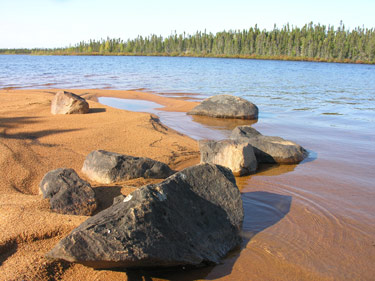Colvin Lake Provincial Park
Northeast Parks

Colvin Lake was established in 2010 along the northwest corner of Manitoba. This 1630 km2 park protects a vast wilderness in the Northern Transition Forest Natural Region which lies between the boreal forest and tundra regions. This area is known as the land of little sticks due to the stunted trees caused by the permafrost. The landscape is dominated by eskers which rise as
high as 50 metres, these sand and gravel deposits are remnants from the last glacial period and combined with the frost-heaved rock and boulder fields make overland travel challenging. A large outcrop of pink granite bedrock around Secter Lake in the southern part of the park is unique to the region. Many of the park’s lakes drain into the Thlewiaza River which then flows to Nueltin Lake Provincial Park and north into Nunuvut. Evidence of pre-contact peoples have been found on the eskers near water ways within the park.
Colvin Lake Provincial Park protects an important and vast landscape relatively undisturbed by human developments. The park is within the range of the Beverly and Qamanirjuaq Barren Ground Caribou herds which are vulnerable to disturbances on the landscape. It is also an important summer breeding habitat for migratory birds and protects habitat for the western population of wolverine (a species of special concern as designated by the Committee on the Status of Endangered Wildlife in Canada).
There are no facilities located in the park, and the park receives a small number of visitors who use the park for hunting, fishing or canoeing. The park is designated for wilderness camping; there are no designated campsites and visitors are expected to camp at an existing site. The park is not road accessible and visitors must make alternate arrangements to visit.
The Park is within the traditional territory of Northlands Denesuline First Nation.


